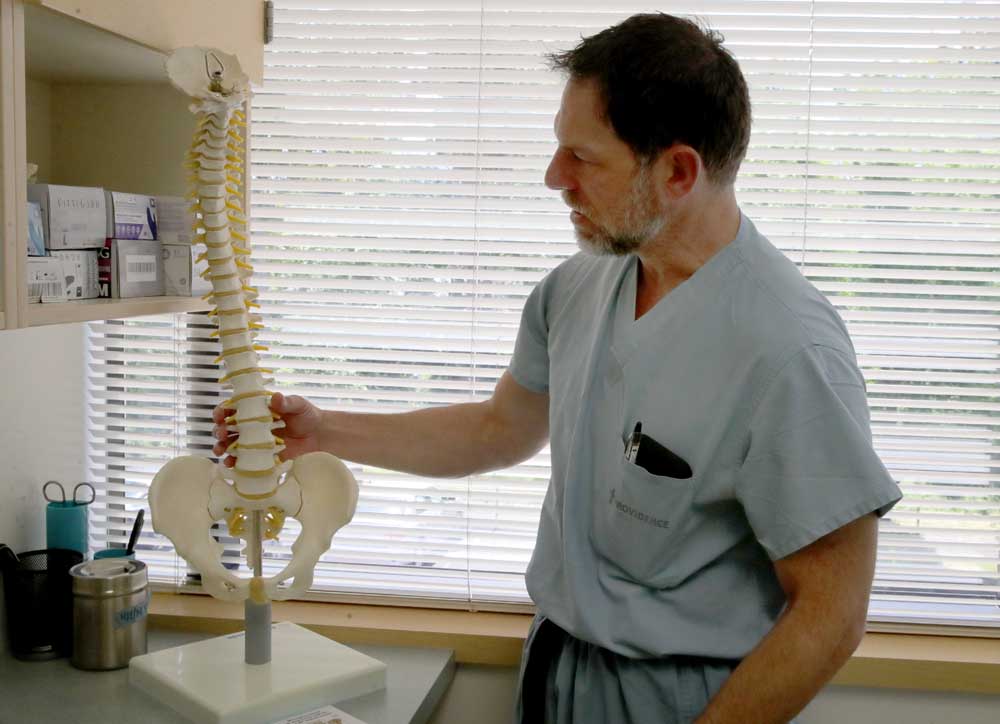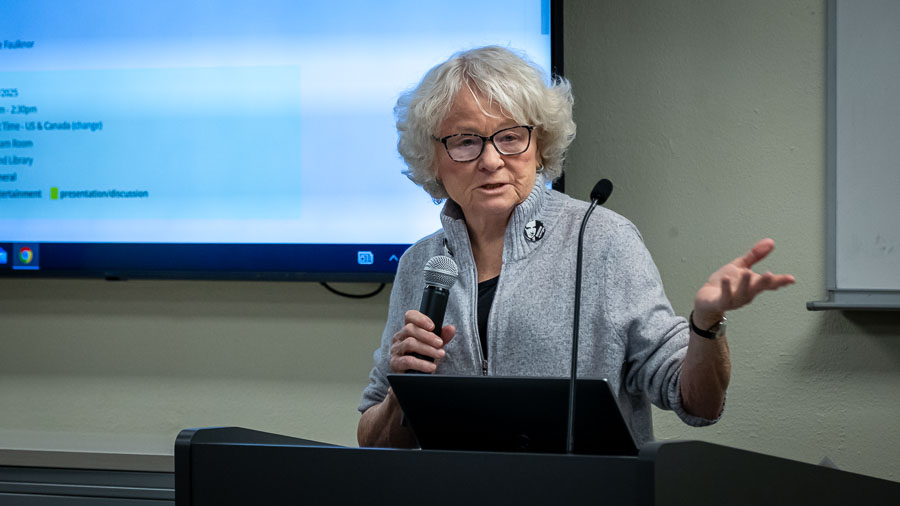500 and counting: Local surgeon hits milestone in back pain procedure
Published 1:00 pm Monday, May 27, 2024

- In his Medford office, orthopedic surgeon Andy Kranenburg points to how problems in the sacroiliac, or SI, joint — which connects the pelvis to the spine — can lead to lower back pain. Kranenburg earlier this month completed his 500th SI joint fusion surgery making him a world leader in the minimally invasive procedure.
A homegrown Rogue Valley doctor recently marked his 500th time using a state-of-the-art surgery that relieves lower back pain by fusing the pelvis to the spine with the aid of 3D-printed titanium implants.
And he has his fingerprints on the implant’s next generation.
On May 10, Dr. Andy Kranenburg completed his 500th sacroiliac joint fusion surgery at Southern Oregon Orthopedics in Medford. The surgery involves a trio of triangular shaped implants that are inserted through a small incision. The procedure typically lasts about an hour, and the patient recovers at home.
The sacroiliac joint, often referred to as the SI joint, connects the inner pelvis to the spine. The joint fusion surgery works by making small incisions into a side of the hip or buttock and inserting a trio of triangular shaped implants into the bone through the joint.
The precisely shaped implants are designed to immediately stabilize the joint in the short term, and in the long term they encourage bone to grow, fusing the joint in place.
Only about 15 surgeons around the world have reached that milestone, Kranenburg said, and just a handful of them are in the United States. He got an early start on the procedure thanks to his training in the San Francisco Bay Area roughly 15 years ago with a pioneer orthopedic surgeon, Dr. Noel Goldthwaite, who Kranenburg described as “just a giant of a thinker in orthopedic surgery.”
“It’s being in the right place at the right time,” Kranenburg said.
The implant, manufactured by the company SI-BONE of Santa Clara, California, is now in its second generation. The first generation was made from precisely machined monoblock titanium sprayed with plasma to encourage bone growth to stabilize the joint.
“The success was incredible,” Kranenburg said.
Made through a 3D-printing process with lasers and titanium powder, the implants are about the size of a person’s pinky finger. They do not set off metal detectors, according to Kranenburg.
“You can go right through the airport with this,” Kranenburg said.
The first generation of implants was approved by the FDA around 2010, and the second generation 3D-printed implants underwent a national multisite study between 2015 and 2021. Kranenburg was one of the principal investigators in that trial for the implant, known as the SI-BONE iFuse 3D, and Medford was a study site with surgeries in the study conducted at Providence.
“It validated that these things are really effective — it has a 90% patient-satisfaction rate,” Kranenburg said. “And this is done as an outpatient surgery. It’s just incredible.”
Surgeries involving the SI joint go back more than a century, but Kranenburg said they were “big, open procedures” that had long recovery times. Only a couple of “oddball” orthopedic surgeons in the country were doing SI joint surgeries a decade and a half ago, each devising their own method “because it didn’t really exist yet.”
Dr. Goldthwaite, one of his attending physicians in the Bay Area, happened to be one of the surgeons experimenting in the field.
“Everybody thought he was crazy, and I was training with him and I would see these patients get better,” Kranenburg said. “So when I moved back to Southern Oregon to practice 15 years ago, I was the only person who even thought about diagnosing this problem and treating it.”
At one point, Kranenburg developed his own prototype for an implant in his barn in Jacksonville. He was in the middle of shopping his idea around when SI-BONE reached out seeking surgeons to work with.
“They did a patent search and found my name on the thing I built and they just called me,” Kranenburg said. “They said, ‘We think we have an answer, but we don’t have any surgeons who believe in it. You seem to be a surgeon who believes in it, but we bet you don’t have an answer.'”
Since teaming up with SI-BONE, Kranenburg has had surgeons fly from around the world to train in Medford. The farthest away included two surgeons from Australia, and he’s flown around the world to train surgeons, including at an international conference in the Bahamas.
Kranenburg also has patents on a new-generation 3D-printed implant shaped like a screw that is designed to be more versatile, usable in cases of high-energy fractures as well as SI joint problems. He said that he receives royalty checks on the patent for implants used out of the area, but not for implants used in his practice or at Southern Oregon Orthopedics.
Kranenburg said he found out about the milestone because SI-BONE sent him a personalized video that day congratulating him.
“I’ve done a few since then,” Kranenburg said.
He estimates that the procedure is about 8% to 10% of his surgical practice. It can be a game-changer for people with lower back pain.
Outcomes are still being studied, but Kranenburg mentioned a handful of outcome studies in the U.S. that found patients’ pain scores can drop by as much as 6 points on a 1-10 scale a month after the surgery, with full improvement taking place within about six months.
However, the surgery is not necessarily Kranenburg’s first resort. Most acute injuries can be addressed using physical therapy if the problem is addressed within three months, he said.
“I can get almost everybody better if they’ve had symptoms less than three months with therapy, but I can only get a minority of them better if they’ve had symptoms for more than three months,” Kranenburg said. “So you can imagine one of the first questions I ask people is, ‘How long have you had this?'”
There is evidence that 20% of people with chronic lower back pain have their SI joint as the “major generator of that pain,” Kranenburg said.
He believes many spinal fusion surgeries are mis-prescribed as a way to treat back pain, and voiced concerns because spinal fusion surgeries can complicate SI joint surgery outcomes.
“If you’ve had parts of your back fused together, it puts more stress on the SI joint,” Kranenburg said.
A test he uses on patients complaining of lower back pain is a physical exam that involves injecting the numbing agent lidocaine in places such as the hip area to find the source of the pain.
“If your lower back hurts, come and let us figure it out,” Kranenburg said.
Kranenburg described how, as a surgeon, an accurate diagnosis is just as important as performing the operation well.
“Being a surgeon is such an amazing job,” Kranenburg said. “The art of the diagnosis — that is absolutely fascinating.”
His practice does not require a referral. For more information about the surgery or to make an appointment, call 541-779-6250.










